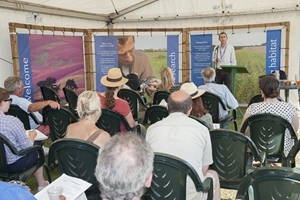 Rearing smarter pheasants, woodcock satellite tracking and black grouse recovery will be among the fascinating research projects that will be featured on the Game & Wildlife Conservation Trust’s stand at the CLA Game Fair at Harewood House, near Leeds, this year.
Rearing smarter pheasants, woodcock satellite tracking and black grouse recovery will be among the fascinating research projects that will be featured on the Game & Wildlife Conservation Trust’s stand at the CLA Game Fair at Harewood House, near Leeds, this year.
Supported by colourful interactive displays, live pheasants and a team of knowledgeable advisors and scientists, there will be something for everybody visiting the stand, including the latest news on the woodcock satellite tagging project, which is now following the hazardous migration journeys of more than 56 tagged birds as they fly back to their breeding grounds in Siberia and beyond.
As part of the GWCT’s display, young pheasant poults will help demonstrate the results of a fascinating three-year behavioural study on pheasants, which was carried out by Mark Whiteside as part of his PhD studies. The project investigated whether simple techniques introduced in the early stages of a reared pheasant’s life would help it survive better once released and this has achieved some remarkable results.
Dr Rufus Sage, the GWCT’s head of lowland gamebird research said, “Our aim was to improve the fitness of the young birds and enable them to adapt more successfully to free-range life before, during and after the shooting season. This project has now ended and we will be outlining the results of the study on our stand as well as providing some useful tips.”
Showing ‘science in action’ by demonstrating how research is getting to grips with the terrible parasite gape worm, which afflicts pheasants and partridges will prove to be a fascinating but gruesome draw to the GWCT stand. Researchers Dr Rufus Sage and Owen Gethings will be graphically demonstrating how the parasite successfully survives in the soil and they will be discussing how to reduce the intensity of this infection around feeding areas.
Adrienne Tollman, the GWCT’s Game Fair organiser, is looking forward to welcoming GWCT members and visitors to the stand and said, “Our wide-ranging displays mean that we will be offering something to suit differing tastes and interests. We are particularly keen to encourage a younger audience and will have a variety of activities and exhibits designed especially with them in mind. This might even inspire them to become the next generation of scientists or wildlife managers.”
“Our welcoming members’ area will definitely be the place to meet friends and guests. In this relaxing setting they will be able to enjoy a selection of delicious home-cooked food from our new caterers throughout the day with a well-stocked bar serving a full selection of soft and alcoholic drinks including a local draught ale and lager. With the help of several sponsors we are able to provide these facilities as cost effectively as possible and this in turn means that your donation will continue to fund our important research.”
The GWCT is delighted that Bright Seeds will be displaying an extensive range of fully grown crops on the stand enabling people to catch up on the latest developments in cover crops, and wildlife bird seed mixes, while Sparsholt College from Hampshire will be demonstrating how they use our science and research in education through their courses and careers advice.
For more information on the GWCT’s stand at the 2015 Game Fair, please contact: Adrienne Tollman, on 01425 651010 or email: atollman@gwct.org.uk
END
Photocaption: GWCT Head of Wetland Research Andrew Hoodless makes a presentation at the GWCT stand at the 2014 CLA Game Fair. Photocredit: © Jon P Farmer.
Notes to editors
The Game & Wildlife Conservation Trust – providing research-led conservation for a thriving countryside. The GWCT is an independent wildlife conservation charity which has carried out scientific research into Britain’s game and wildlife since the 1930s. We advise farmers and landowners on improving wildlife habitats. We employ 22 post-doctoral scientists and 50 other research staff with expertise in areas such as birds, insects, mammals, farming, fish and statistics. We undertake our own research as well as projects funded by contract and grant-aid from Government and private bodies. The Trust is also responsible for a number of Government Biodiversity Action Plan species and is lead partner for grey partridge and joint lead partner for brown hare and black grouse.
For information, contact:
Eleanor Williams
Telephone: 07592 025476
Email: press@gwct.org.uk